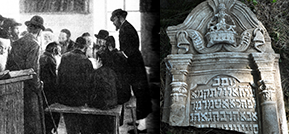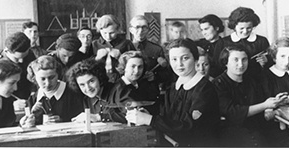About twenty-five synagogues and small prayer houses existed in Nadworna in the interwar period (Shmuel Hübner, "Di rabonim un admorim in nedverne," Sefer Nadvurna, 25-6 [Heb.], 124, 126 [Yid.]).
On the synagogue street (shil-gas) several synagogues were concentrated around the Great Town Synagogue, known as di groyse shul or di shtot-shul (Josef Schmerler, "The Old Synagogue," Sefer Nadvurna, 31 [Heb. Part], 55 [Eng. Part]; Hübner, "Di rabonim un admorim in nedverne," Sefer Nadvurna, 26 [Heb.], 125 [Yid.]). In the building of the Great Synagogue there was the synagogue of local tailors and the kloyz of the hasidim of Rabbi Mordechai of Nadworna (Hübner, "Di rabonim un admorim in nedverne," Sefer Nadvurna, 26 [Heb.], 125 [Yid.]). The Great Synagogue was the only local synagogue which was not damaged by the pre-World War I fire of 1914 (Shmuel Kahana, "Ha-srefa ha-gdola be-nadvorna, 1914," Sefer Nadvurna, 119).
In the Old Beit Midrash prayed middle class non-Hasidic Jews, among them the dayan R. Meir Weisblum (Shmuel Hübner, "Di rabonim un admorim in nedverne," Sefer Nadvurna, 26 [Heb.], 125 [Yid.]).
The New Beit Midrash was formerly the kloyz of Kock Hasidim (Shmuel Hübner, "Di rabonim un admorim in nedverne," Sefer Nadvurna, 26 [Heb.], 125 [Yid.]). In front of it stood the Magid's kloyz, named after the preacher R. Tzvi Hirsh Filip (Hübner, "Di rabonim un admorim in nedverne," Sefer Nadvurna, 26 [Heb.], 125 [Yid.]).
The Old Kosov Hasidim kloyz belonged to Haim Brandwein, who was a descendant of the Stretyn Hasidic dynasty. He ran it, according to one source, "like a dictator" When it became too small for all its members, the New Kosov Hasidim kloyz was built nearby (Hübner, "Di rabonim un admorim in nedverne," Sefer Nadvurna, 25 [Heb.], 124 [Yid.]).
Next to it stood the non-Hasidic synagogue, the German shul (deitche shilkhel) (Schmerler, "The Old Synagogue," Sefer Nadvurna, 31 [Heb. Part], 55 [Eng. Part]; Hübner, "Di rabonim un admorim in nedverne," Sefer Nadvurna, 26 [Heb.], 125 [Yid.]).
In the Otynia Hasidim kloyz the wealthy members of the community prayed (Hübner, "Di rabonim un admorim in nedverne," Sefer Nadvurna, 25 [Heb.], 125 [Yid.]).
In the neighboring kloyz of Vizhnits Hasidim prayed the dayan R. Yeshayah Friedman (Hübner, "Di rabonim un admorim in nedverne," Sefer Nadvurna, 26 [Heb.], 125 [Yid.]).
The synagogue of Rabbi Moshe Leifer, the rebbe from Nadworna, stood in a side alley near Stanislawow Street. There prayed the family Knoll (Hübner, "Di rabonim un admorim in nedverne," Sefer Nadvurna, 26 [Heb.], 126 [Yid.]).
The kloyz of the family Budner was built by Moshe Budner near the town hall (Hübner, "Di rabonim un admorim in nedverne," Sefer Nadvurna, 26 [Heb.], 126 [Yid.]).
There were also the kloyzn of Belz and Czortkow Hassidim (Pinkas Hakehilot, 329) and a shtibl in the the house of Haim Bickel (Hübner, "Di rabonim un admorim in nedverne," Sefer Nadvurna, 39 [Heb.], 126 [Yid.]).
All synagogues were destroyed in the Soviet period (Grandeur and Glory, 1:163-5).






